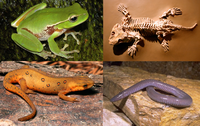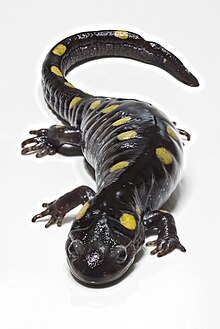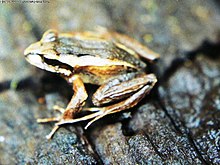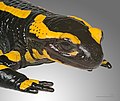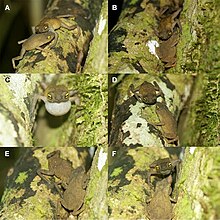Introduction
Selected amphibian type
Salamanders are a group of amphibians typically characterized by their lizard-like appearance, with slender bodies, blunt snouts, short limbs projecting at right angles to the body, and the presence of a tail in both larvae and adults. All ten extant salamander families are grouped together under the order Urodela from the group Caudata. Urodela is a scientific Latin term based on the Ancient Greek οὐρά δήλη: ourà dēlē "conspicuous tail". Caudata is the Latin for "tailed ones", from cauda : "tail".
Salamander diversity is highest in eastern North America, especially in the Appalachian Mountains; most species are found in the Holarctic realm, with some species present in the Neotropical realm. Salamanders never have more than four toes on their front legs and five on their rear legs, but some species have fewer digits and others lack hind limbs. Their permeable skin usually makes them reliant on habitats in or near water or other cool, damp places. Some salamander species are fully aquatic throughout their lives, some take to the water intermittently, and others are entirely terrestrial as adults.
This group of amphibians is capable of regenerating lost limbs as well as other damaged parts of their bodies. Researchers hope to reverse engineer the regenerative processes for potential human medical applications, such as brain and spinal cord injury treatment or preventing harmful scarring during heart surgery recovery. The remarkable ability of salamanders to regenerate is not just limited to limbs but extends to vital organs such as the heart, jaw, and parts of the spinal cord, showing their uniqueness compared to different types of vertebrates. This ability is most remarkable for occurring without any type of scarring. This has made salamanders an invaluable model organism in scientific research aimed at understanding and achieving regenerative processes for medical advancements in human and animal biology. ( Full article...)
Selected frog article
Batrachylidae is a family of frogs from southern South America ( Argentina and Chile). Before being recognized as a family, Batrachylidae was included as a subfamily (Batrachylinae) in the family Ceratophryidae; this is the taxonomy still suggested by the Integrated Taxonomic Information System (ITIS). ( Full article...)
Selected salamander article
Ambystomatidae is a family of salamanders belonging to the Suborder Salamandroidea in the class Amphibia. It contains two genera, Ambystoma (the mole salamanders) and Dicamptodon (the Pacific giant salamanders). Ambystoma contains 32 species and are distributed widely across North America, while Dicamptodon contains four species restricted to the Pacific Northwest. These salamanders are mostly terrestrial and eat invertebrates, although some species are known to eat smaller salamanders. They can be found throughout the US and some areas of Canada in damp forests or plains. This family contains some of the largest terrestrial salamanders in the world, the tiger salamander and the coastal giant salamander. Some species are toxic and can secrete poison from their bodies as protection against predators or infraspecific competition. Neoteny has been observed in several species in Ambystomatidae, and some of them like the axolotl live all of their lives under water in their larval stage. ( Full article...)
The page " User:The Transhumanist/Sandbox144/box-header" does not exist. The page " User:The Transhumanist/Sandbox144/DYK/32" does not exist.
Picture slideshow
Selected toad article
Frostius – known as Frost's toads – is a small genus of true toads consisting of only two species endemic to Brazil. The genus was proposed by David C. Cannatella in 1986 based on an analysis of a species previously classified as Atelopus. Various morphological and life-history information first suggested that it is sister taxon to Atelopus or Atelopus + Osornophryne, but later molecular evidence suggests that it is sister taxon to Oreophrynella. It was named for Darrel Frost in recognition of his work on anuran systematics. ( Full article...)
Selected caecilian article
Gegeneophis ramaswamii, common names Tenmalai caecilian, Tenmalai blind caecilian, Ramaswami's caecilian, and forest caecilian is a species of caecilian. It is endemic to the southern portion of the Western Ghats, India, and is recorded from Kerala and Tamil Nadu. The specific name ramaswamii honours L. S. Ramaswami, an Indian herpetologist. ( Full article...)
Categories
Topics
Related portals
Associated Wikimedia
The following Wikimedia Foundation sister projects provide more on this subject:
-
Commons
Free media repository -
Wikibooks
Free textbooks and manuals -
Wikidata
Free knowledge base -
Wikinews
Free-content news -
Wikiquote
Collection of quotations -
Wikisource
Free-content library -
Wikiversity
Free learning tools -
Wiktionary
Dictionary and thesaurus
Introduction
Selected amphibian type
Salamanders are a group of amphibians typically characterized by their lizard-like appearance, with slender bodies, blunt snouts, short limbs projecting at right angles to the body, and the presence of a tail in both larvae and adults. All ten extant salamander families are grouped together under the order Urodela from the group Caudata. Urodela is a scientific Latin term based on the Ancient Greek οὐρά δήλη: ourà dēlē "conspicuous tail". Caudata is the Latin for "tailed ones", from cauda : "tail".
Salamander diversity is highest in eastern North America, especially in the Appalachian Mountains; most species are found in the Holarctic realm, with some species present in the Neotropical realm. Salamanders never have more than four toes on their front legs and five on their rear legs, but some species have fewer digits and others lack hind limbs. Their permeable skin usually makes them reliant on habitats in or near water or other cool, damp places. Some salamander species are fully aquatic throughout their lives, some take to the water intermittently, and others are entirely terrestrial as adults.
This group of amphibians is capable of regenerating lost limbs as well as other damaged parts of their bodies. Researchers hope to reverse engineer the regenerative processes for potential human medical applications, such as brain and spinal cord injury treatment or preventing harmful scarring during heart surgery recovery. The remarkable ability of salamanders to regenerate is not just limited to limbs but extends to vital organs such as the heart, jaw, and parts of the spinal cord, showing their uniqueness compared to different types of vertebrates. This ability is most remarkable for occurring without any type of scarring. This has made salamanders an invaluable model organism in scientific research aimed at understanding and achieving regenerative processes for medical advancements in human and animal biology. ( Full article...)
Selected frog article
Batrachylidae is a family of frogs from southern South America ( Argentina and Chile). Before being recognized as a family, Batrachylidae was included as a subfamily (Batrachylinae) in the family Ceratophryidae; this is the taxonomy still suggested by the Integrated Taxonomic Information System (ITIS). ( Full article...)
Selected salamander article
Ambystomatidae is a family of salamanders belonging to the Suborder Salamandroidea in the class Amphibia. It contains two genera, Ambystoma (the mole salamanders) and Dicamptodon (the Pacific giant salamanders). Ambystoma contains 32 species and are distributed widely across North America, while Dicamptodon contains four species restricted to the Pacific Northwest. These salamanders are mostly terrestrial and eat invertebrates, although some species are known to eat smaller salamanders. They can be found throughout the US and some areas of Canada in damp forests or plains. This family contains some of the largest terrestrial salamanders in the world, the tiger salamander and the coastal giant salamander. Some species are toxic and can secrete poison from their bodies as protection against predators or infraspecific competition. Neoteny has been observed in several species in Ambystomatidae, and some of them like the axolotl live all of their lives under water in their larval stage. ( Full article...)
The page " User:The Transhumanist/Sandbox144/box-header" does not exist. The page " User:The Transhumanist/Sandbox144/DYK/32" does not exist.
Picture slideshow
Selected toad article
Frostius – known as Frost's toads – is a small genus of true toads consisting of only two species endemic to Brazil. The genus was proposed by David C. Cannatella in 1986 based on an analysis of a species previously classified as Atelopus. Various morphological and life-history information first suggested that it is sister taxon to Atelopus or Atelopus + Osornophryne, but later molecular evidence suggests that it is sister taxon to Oreophrynella. It was named for Darrel Frost in recognition of his work on anuran systematics. ( Full article...)
Selected caecilian article
Gegeneophis ramaswamii, common names Tenmalai caecilian, Tenmalai blind caecilian, Ramaswami's caecilian, and forest caecilian is a species of caecilian. It is endemic to the southern portion of the Western Ghats, India, and is recorded from Kerala and Tamil Nadu. The specific name ramaswamii honours L. S. Ramaswami, an Indian herpetologist. ( Full article...)
Categories
Topics
Related portals
Associated Wikimedia
The following Wikimedia Foundation sister projects provide more on this subject:
-
Commons
Free media repository -
Wikibooks
Free textbooks and manuals -
Wikidata
Free knowledge base -
Wikinews
Free-content news -
Wikiquote
Collection of quotations -
Wikisource
Free-content library -
Wikiversity
Free learning tools -
Wiktionary
Dictionary and thesaurus
